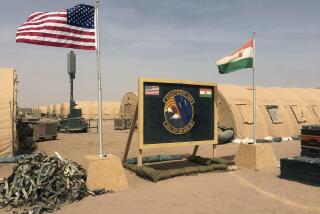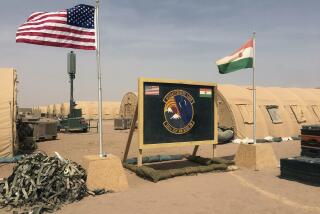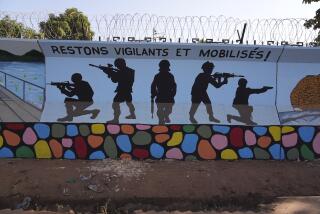U.S. halts most combat missions in Africa in response to findings on deadly Niger ambush
Reporting from Washington â U.S. special operations troops in Africa have been restricted from undertaking missions that might involve direct combat, one of several steps announced Thursday to prevent future casualties after an October ambush in Niger killed four American soldiers.
U.S. forces have not conducted any operations to kill or capture militants since the deadly confrontation and are focused almost exclusively on training Nigerien troops and other U.S. allies in the region and expanding an airfield outside Nigerâs capital for drone operations, commanders told reporters at a Pentagon news conference on the results of the military investigation into the Niger attack.
âWe are now far more prudent in our missions,â said Marine Gen.Thomas Waldhauser, the commander of U.S. Africa Command, which oversees military operations on the continent. âU.S. forces are not to be involved in direct combat.â
The new restrictions are perhaps the most far-reaching consequence of the seven-month investigation into the ferocious Oct. 4 ambush of the dozen American soldiers and more than 30 Nigeriens who battled for their lives during a gunfight lasting more than an hour against about 100 militants 20 miles south of the Mali border.
The attack caused a public relations furor for the White House last October after President Trump took several days to reach out to the soldiersâ families and then was accused of making insensitive remarks to Sgt. La David Johnsonâs widow, which a Democratic congresswoman from Florida said she overheard. The White House denied that the presidentâs effort to console the widow was inappropriate.
Johnson was initially unaccounted for and his body wasnât found until after a two-day search, and then by Nigerien villagers. The search was delayed, the report noted, after the U.S. received inaccurate reports that Johnson was being held prisoner in a village north of the ambush site.
The Pentagon released an eight-page summary of the investigation Thursday, but withheld the entire 6,300-page report containing witness statements, photographs and other evidence, saying it was still seeking to have the material declassified.
It also made public portions of a 21-minute video that seeks to reconstruct the more than hourlong attack. The full video was shown to Congress, but the Pentagon had decided against releasing it publicly in its entirety to avoid making public âtoo much information,â Waldhauser said.
The investigation blamed âindividual, organizational, and institutional failures and deficiencies that contributed to the tragic events of 4 October 2017,â according to the summary. But it said that âno single failure or deficiency was the sole reason.â
Maj. Gen. Roger Cloutier Jr., the investigating officer, noted that âAmerican and Nigerien soldiers fought courageously ⌠despite being significantly outnumbered by the enemy,â according to the report.
The investigation criticizes two Army captains â one in charge of the 12-man unit targeted in the ambush and another at the unitâs Niger headquarters â for not disclosing to superiors before they headed out that they were conducting a potentially dangerous kill-or-capture mission against Doundou Cheffou, the leader of an Islamic State affiliate who is believed to be involved in the kidnapping of a U.S. aid worker.
The officers said they would be meeting with tribal chiefs, which âinaccurately characterized the nature of the mission,â the report said, adding that more senior commanders were unaware of the true goal of the mission.
Since the attacks, the Pentagon has provided armored vehicles, more drones and other equipment to better protect U.S. troops, Waldhauser said. But the U.S. will only conduct combat missions when critical for protecting the U.S., he said.
The report did not recommend taking disciplinary action against the officers, Waldhauser said, saying it would be up to U.S. Special Operations Command to decide whether to do so.
U.S. soldiers didnât train adequately before they deployed and did not conduct battle drills with their Nigerien partners before the mission, the report said.
After the mission to capture Cheffou was unsuccessful, the convoy of eight vehicles carrying the U.S. and Nigerien soldiers was returning to home base and stopped at the village of Tongo Tongo to get water. As they drove away, Islamic State-linked militants attacked with small arms, rocket-propelled grenade launchers, and machine guns mounted on trucks.
Initially, the soldiers exited the vehicles and began returning fire, according to the report.
âRealizing that the team was significantly outnumbered by a well-trained force,â the U.S. commander ordered a withdrawal, the report says. But Staff Sgt. Bryan C. Black, Staff Sgt. Dustin M. Wright and Staff Sgt. Jeremiah W. Johnson along with several Nigerien soldiers were pinned down, unable to withdraw with the rest of the team, the report said.
Black took cover behind one vehicle but was hit by gunfire, killing him instantly.
As enemy fighters came closer, Wright and Jeremiah Johnson âwere forced to evade on foot,â until they too were killed, the report said.
The rest of the Americans and Nigerien soldiers formed a defensive position 600 yards away. Four U.S. soldiers moved on foot back to the original ambush position, seeking unsuccessfully to find the pinned-down members of the team.
But they came under increasingly intense fire from militants, who were slowly surrounding their position. La David Johnson was lying on the ground, firing back, when the U.S. commander ordered another withdrawal.
The gunfire was so intense that La David Johnson and two Nigerien soldiers were unable to get into a vehicle. âWith enemy forces rapidly closing on their position, they were forced to evade on foot.â
After the two Nigerien soldiers were killed, La David Johnson ran 400 yards, eventually taking cover under a thorny tree, the only cover available in the arid landscape. He was killed by small-arms fire.
The attackers were eventually driven off, after the U.S. team radioed that they were under attack. Two French Mirage warplanes rushed to the scene and conducted several low-level passes, scaring off the militants. The pilots were not in radio contact with the ground troops and so could not fire weapons, another deficiency noted by the report.
Because of the remoteness of the ambush site and the lack of planning for possible casualties, it took nearly six hours for helicopters carrying French soldiers to arrive at the ambush site to evacuate the wounded.
None of the four Americans killed was captured alive by the enemy, and all died immediately or quickly from their wounds.
Contrary to some media reports, the investigation found that La David Johnsonâs hands were not bound when his body was found two days later and he âwas not executed.â
Twitter: @davidcloudLAT
More to Read
Sign up for Essential California
The most important California stories and recommendations in your inbox every morning.
You may occasionally receive promotional content from the Los Angeles Times.











